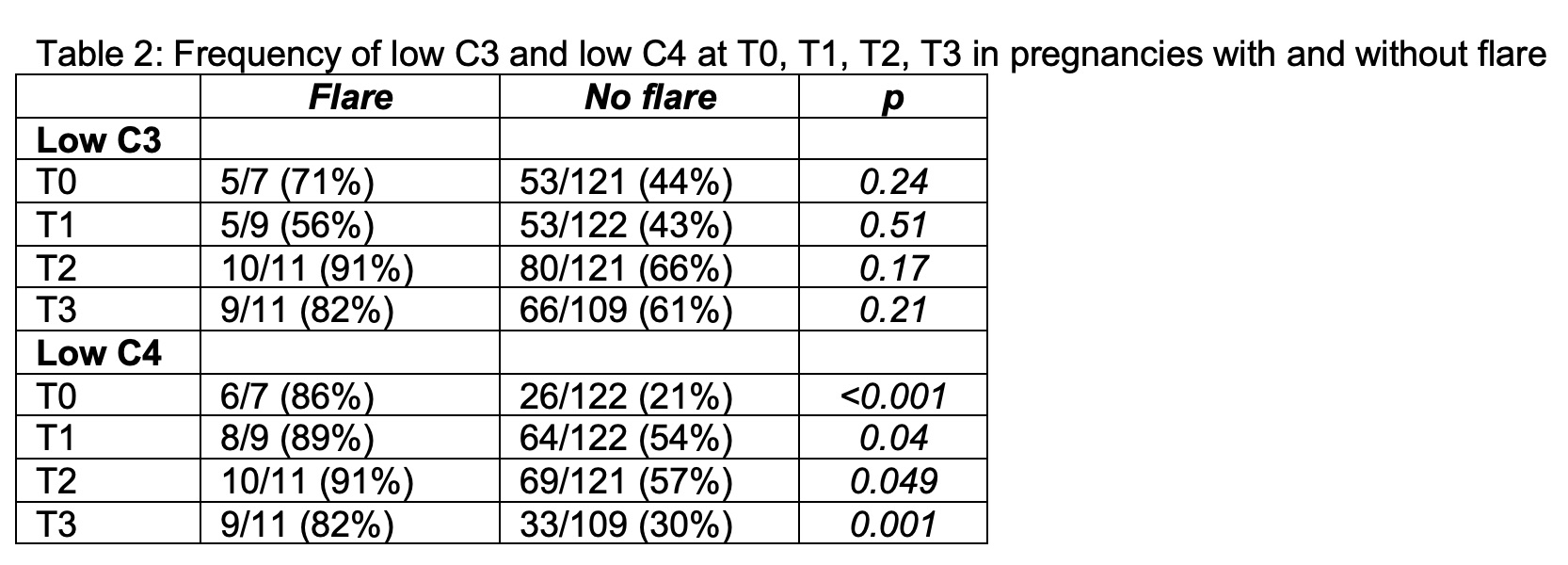Session Information
Date: Friday, November 6, 2020
Title: SLE – Diagnosis, Manifestations, & Outcomes Poster I: Clinical Manifestations
Session Type: Poster Session A
Session Time: 9:00AM-11:00AM
Background/Purpose: SLE pregnancies have an increased risk of Adverse Pregnancy Outcomes (APO). In clinical practice, low C3 and C4 levels are associated with active disease and, during pregnancy, complement activation products are shown to be associated with APO. Our aim was to analyse C3 and C4 variations during SLE pregnancies, focusing on APO and disease flares.
Methods:
Data on SLE pregnancies prospectively-followed by a multidisciplinary team from 1987 to 2017 were analysed. Serum C3 and C4 levels were recorded at preconception visit (T0) and each trimester (T1, T2, T3). Hypocomplementemia was defined according to the normality range calculated in healthy pregnancies by Reggia et al. APO were defined as: early miscarriage (< 10thweek), intrauterine fetal death (IFD, >10thweek), perinatal death (< 30thday of life), pre-eclampsia (PE), severe preterm birth (< 34thweek).
Results: 153 pregnancies in 106 SLE patients were analysed. APO occurred in 25 (16%): 13 early miscarriages, 4 IFD, 3 severe preterm births, 7 PE (hesitated in 2 IFD and 7 live births); 13 flares (2 renal, 4 articular, 6 cutaneous and 1 neurological) were recorded in 11 (7%) pregnancies.
In pregnancies with flares C3 was lower at T2 and T3 as compared with pregnancies without flare while C4 was lower at T0 and T3 (fig 1). There was no difference between pregnancies with and without APO.
Considering the overall pregnancies, C3 progressively increased from T0 to T3, while it remained stable between T2-T3 in the flare group and between T0-T1 and T2-T3 in the APO group (tab1).
In the flare group, C4 increased only between T0-T1 while in the APO group it remained stable throughout pregnancy. Notably, in pregnancies without APO, C4 increased from T0 to T2.
In pregnancies with APO, the variation of C4 levels between T2-T3 trimester was lower than in pregnancies without APO (mean: -2.98 [SD 0.05] vs 0,4 [SD 3.05]; p=0.03).
The frequency of low C4 was higher in pregnancies with flare at T0 and at each trimester as compared with pregnancies without flares (tab2).
Conclusion: Low C4 at pre-conceptional visit seems to predict flares during pregnancy. Lower increase of C4 levels between the 2nd and the 3rdtrimester could predict APO.
To cite this abstract in AMA style:
Crisafulli F, Andreoli L, Filippini M, Fredi M, Gerardi M, Gorla R, Lazzaroni M, Lini D, Nalli C, Taglietti M, Lojacono A, Zatti S, Zanardini C, Franceschini F, Tincani A. SLE Pregnancies: C4 as Predictor of Flares and Adverse Pregnancy Outcomes [abstract]. Arthritis Rheumatol. 2020; 72 (suppl 10). https://acrabstracts.org/abstract/sle-pregnancies-c4-as-predictor-of-flares-and-adverse-pregnancy-outcomes/. Accessed .« Back to ACR Convergence 2020
ACR Meeting Abstracts - https://acrabstracts.org/abstract/sle-pregnancies-c4-as-predictor-of-flares-and-adverse-pregnancy-outcomes/



